There are many types of grass in this world – some suitable for lawn use, some for ornamental use, some for grazing, and some for other uses most of us don’t even think about. And if you’re prepping your lawn for new grass, you’re probably wondering which type is best for your use: St Augustine grass vs. centipede grass. Is either any good? Will either meet your needs? What’s the difference anyway?
Let’s take a look at these two popular grass types that have many species and cultivars to choose from and see if either is the grass you’re looking for.
| St. Augustine Grass | Centipede Grass | |
|---|---|---|
| Classification | Stenotaphrum secundatum; 10+ cultivars of the grass | Eremochloa ophiuroides; 8 species |
| Description | St. Augustine grass is a robust, dark green grass with no rhizomes, overlapping leaf sheathes, and folded blades that create a dense layer over the surface. | Centipede grass is a creeping, short, upright grass that looks a bit like a centipede. The grass is coarse and yellow-green in color. |
| Uses | St. Augustine grass is primarily used as lawn and pastureland grass in hot, humid, and/or coastal climates. | Centipede grass is primarily used in parks, lawns, golf courses, and as utility turf in lower traffic areas. |
| Origins and Growing Preferences | St. Augustine grass originated in the Gulf of Mexico region, Western Africa, and the West Indies, though it was reported prior to the 1800s in many regions of the world. The grass requires warm weather and full sun to thrive. | This tropical grass originated in southeast Asia and China in their warmer climates and was brought to the USA in 1916. The grass is heat and shade tolerant (to a degree) and thrives in full sun with little maintenance. |
| Special Features and Fun Facts | This grass is known as buffalo grass partially due to its pastureland use in South Africa. The grass is also deeply rooted and thrives in salty air climates. It does not produce many seeds, however, so most folks only find success through planting it as sod. | Centipede grass needs warm weather to thrive – and pops out its brightest greens in hot weather only, and happily endures the heat of full sun in summery, hot climates. |
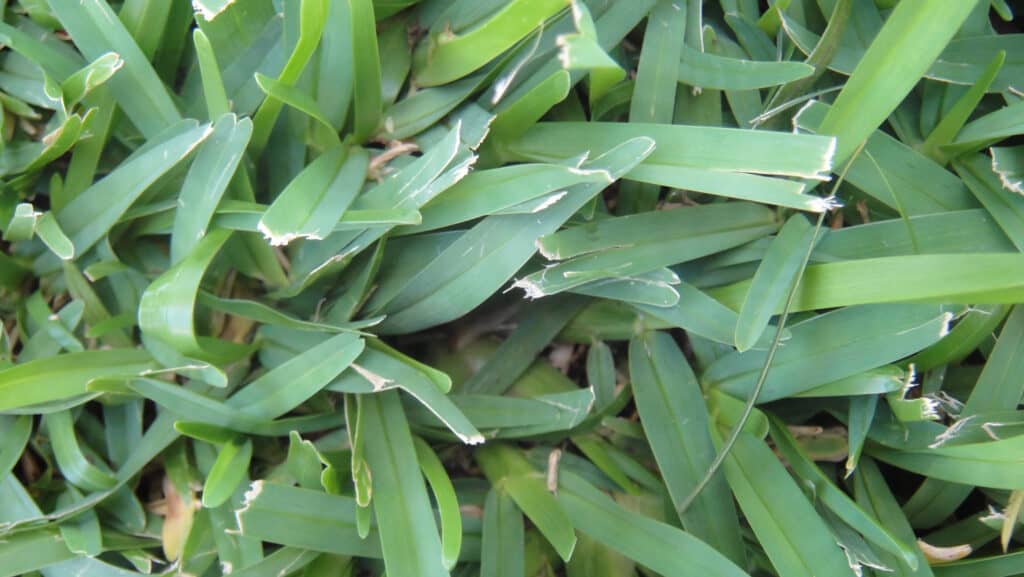
A close-up view of centipede grass reveals the coloration of the blades.
©MarkS26/Shutterstock.com
Key Differences Between St. Augustine Grass and Centipede Grass
There are many types of grass in this world, from ornamental grasses that grow along the coast in lush clutches of wildly waving fronds to lawn and pasture grasses which we enjoy on a more daily basis in the noncoastal areas. But what makes the various lawn grasses stand apart from each other? Let’s take a look at these two popular coastal and hot climate grasses: St Augustine grass vs. centipede grass and what makes them unique from each other.
St. Augustine Grass vs. Centipede Grass: Classification
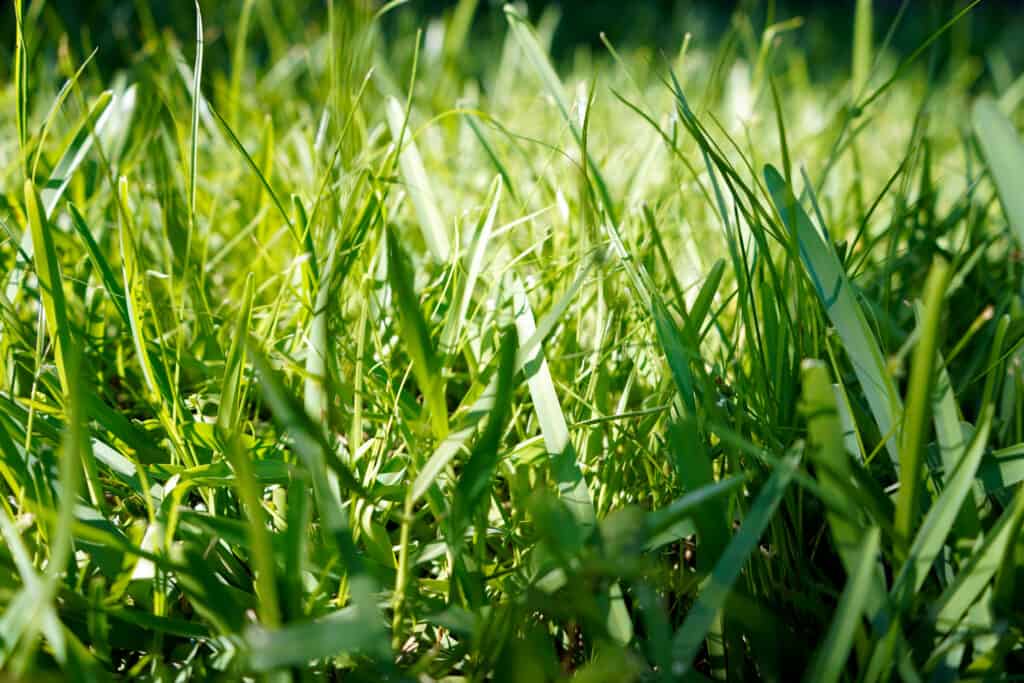
St. Augustine grass offers lush lawn and pasture coverage.
©JennLShoots/Shutterstock.com
Belonging to the Poaceae family, in the Stenotaphrum genus, St. Augustine grass has a number of species and types, with 10 commonly used types found in lawns and pasturelands. This type of grass is commonly nicknamed carpet grass (in the Southeastern United States and California), wire grass (in St. Helena), buffalo grass (in Australia and South Pacific), buffalo turf (in South Africa), crabgrass (in Bermuda and the West Indies), and gramillon (in Argentina).
Centipede grass belongs to the same family, Poaceae, in the subfamily Panicoideae and genus Eremochloa. This is the only species that has been cultivated for turf from the eight species in the Eremochloa genus. The scientific name for centipede grass is Eremochloa ophiuroides. It is a tropical grass and is often called the “lazy man’s grass” because of its low maintenance nature.
St. Augustine Grass vs. Centipede Grass: Description
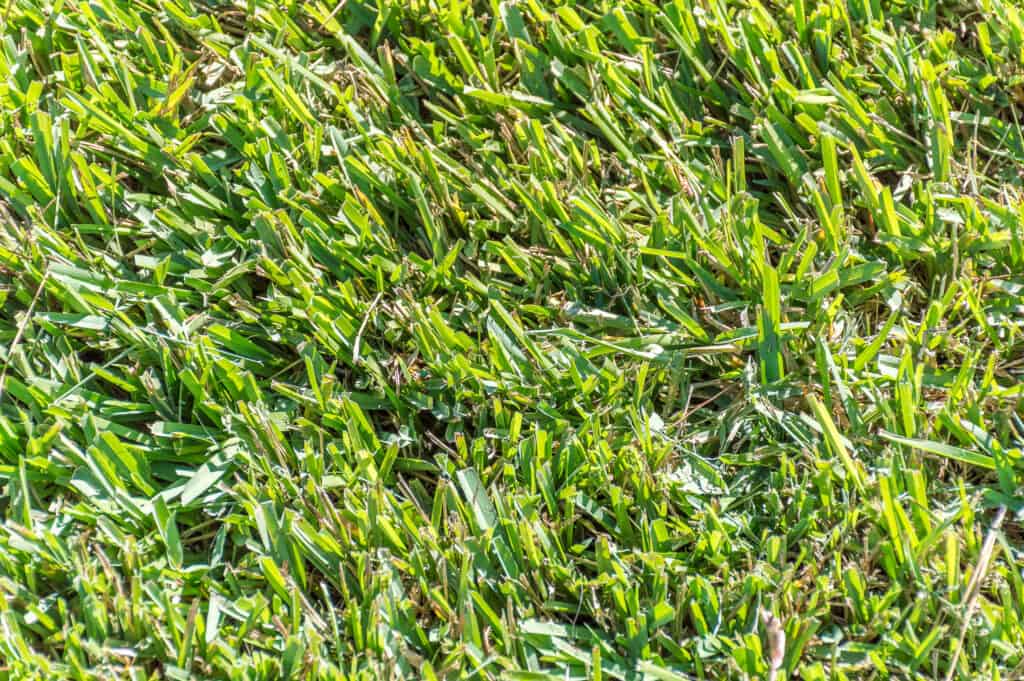
Centipede grass is easy maintenance, earning it the “lazy man’s grass” nickname.
©Craig Russell/Shutterstock.com
St. Augustine grass is described as a robust perennial grass used primarily for lawn and pasture grasses. The grass blades are coarsely textured, with node roots and no rhizomes. The stems, or stolons, and overlapping leaf sheathes generally are compressed, with folded bladed that spread to open at the base. The leaves have rounded, smooth tips. The blades are broad and dark green, creating a dense layer over the surface where it is planted.
With a creeping growth habit, centipede grass also spreads its stolons (stems), but in a rather short upright manner that looks a bit like a centipede (giving it its name). The grass is coarse textured and perennial, in yellow-green shades.
St. Augustine Grass vs. Centipede Grass: Uses
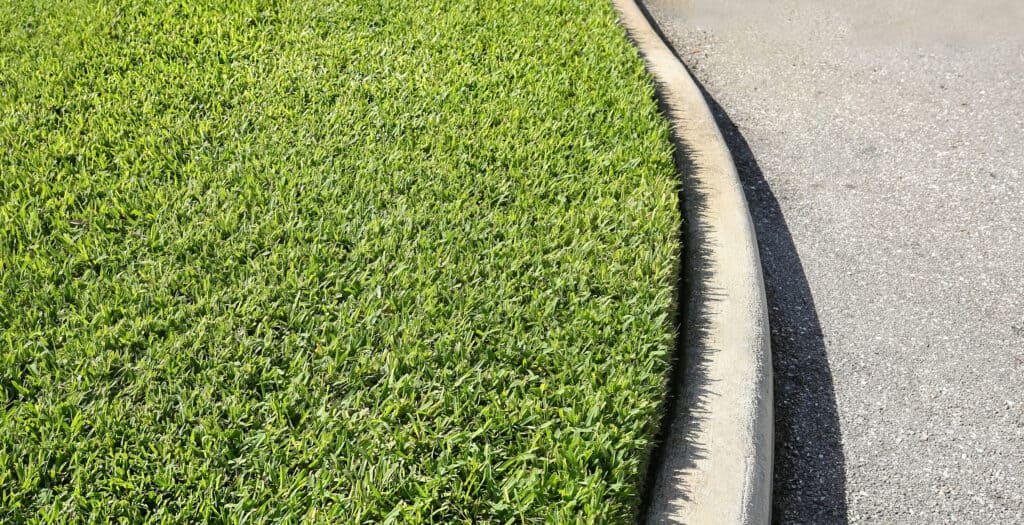
Healthy St. Augustine grass looks amazing as curbed lawn.
©iStock.com/JillianCain
Both St. Augustine grass and centipede grass as primarily used as lawn grasses in warm climates. St. Augustine grass thrives in warm, humid climates with milder winters, while centipede grass thrives in hot climates with mild winters. St. Augustine grass is primarily used for lawns with low traffic use, providing a turf cover in warm, humid climates, and warm dry climates when properly irrigated. It is also a popular choice for pasture grass in coastal and hot, unshaded regions. This helps to make St. Augustine grass one of the most popular grasses in the Gulf states, and particularly Florida, especially since it has high tolerance for salt.
Centipede grass is used largely for parks, lawns, golf course roughs, and utility turf. It does not tolerate heavy traffic, however, so is not well-suited to athletic playing fields and should be kept away from those parts of parks. Generally, it considered a good quality, low-maintenance general purpose turf.
St. Augustine Grass vs. Centipede Grass: Origins and Growing Preferences
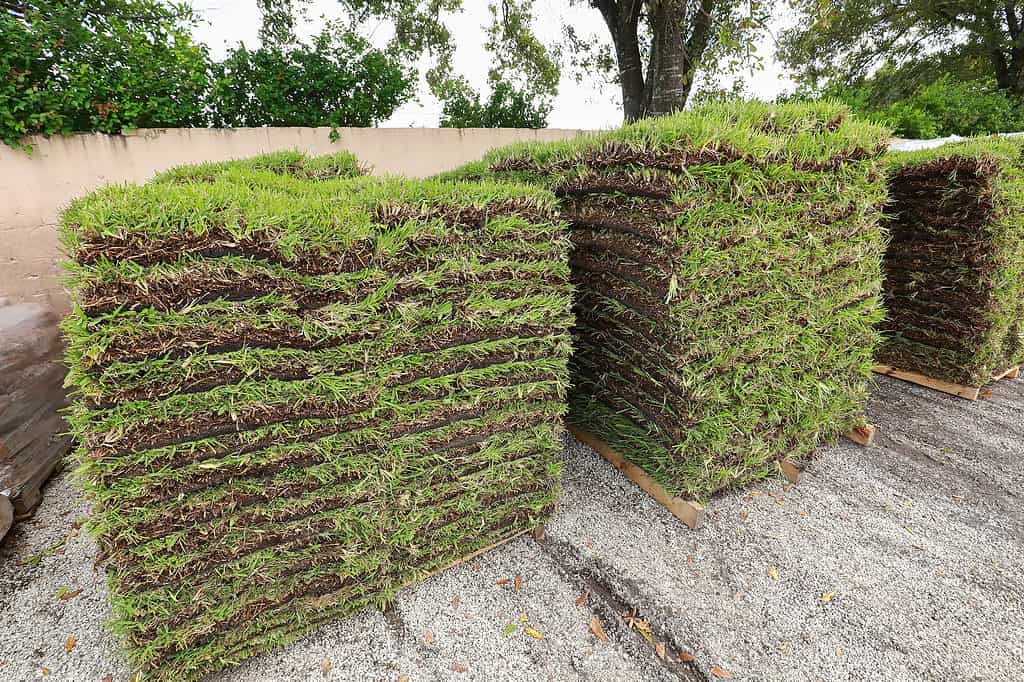
St. Augustine grass is best planted as sod.
©Jillian Cain Photography/Shutterstock.com
St. Augustine grass is widely used throughout the world in hot climates, such as those found in southern Mexico, throughout the Caribbean, in Western Africa, and Australia. The species is of tropical origin, native to the Gulf of Mexico region, Western Africa, and the West Indies. The grass has been reported as a coastal grass for as long as they’ve kept records on such things, dating back before the 1800s. Before the 1800s, the grass was reported in Brazil, Nigeria, Sierra Leone, Bermuda, the West Indies, Uruguay, South Carolina, and Kauai. By 1840, it had been reported in Australia and New Zealand. There are many strains or variants that have reported throughout the world as well, with early records showing a white stigma color in fertile diploids and purple-colored stigmas in sterile triploids. The grass has been planted intentionally in the Congo, Zimbabwe, Senegal, Southern California, Australia, and Florida. Basically, if there’s a sandy beach region nearby, you’ll likely find this grass thriving.
This particular type of grass does best in warm weather, from spring into early autumn, especially in higher temperatures around 80 to 100 degrees Fahrenheit. You’ll want to plant your St. Augustine grass plugs or sod in full sun, at least three months before the first anticipated frost of the season to allow it to establish first.
Centipede grass originated in southeast Asia and China in warmer regions and was brought to the United States in 1916. The grass is primarily found in the southeastern regions of the USA and in Hawaii. The grass is more tolerant of shade than Bermuda grass, which is part of why it was introduced and how it became a popular low-maintenance lawn grass around that time.
The grass has a bad rep as a weed, but it’s actually an excellent lawn grass in hot weather climates such as Florida. It needs proper lawn care, fertile soil, and plenty of water to thrive, but when it does have those things, it’s easy to maintain attractively. It needs hot weather in summer and warmer temperatures in winter (i.e., this is a tropical grass!), it requires little nutritional supplementation, and has moderate shade tolerance. You plant it either as seed or sod, planting seed once frost danger has passed, in well-watered soil. Plant sod in well-watered soil between April and September. Keep the soil moist in either case until the grass has time to take root and begin growing well.
St. Augustine Grass vs. Centipede Grass: Special Features and Fun Facts

St. Augustine grass is also commonly known as buffalo turf or buffalo grass.
©Sherry Barr Photography/Shutterstock.com
St. Augustine grass is also commonly known as buffalo turf or buffalo grass in South Africa because, well, buffalo eat it there. And those tropical origins for this grass give it high levels of tolerance for many things, including specifically salt (coastal climates) and shade (woodland margins). The grass produces deeper roots than many other grasses as well, to help keep itself alive if drought should hit. The grass crowds out most weeds that might hit your lawn, too, so it’s a great choice for folks looking for lower maintenance grass selections. The grass, however, only produces a few seeds, unlike some other popular grasses. This means you’ll do best to let the experts grow it from seeds for you and install sod instead.
Centipede grass is another tropical plant that requires warm weather for it to thrive. That’s why this grass doesn’t pop as bright green leafiness until early to mid-summer when the heat hits in cooler climates. Its high heat tolerance keeps it green all summer, even through some drier times. Centipede grass is the perfect choice for folks looking for low maintenance lawns, too, as the grass doesn’t need high quality soil and can tolerate both shade and sun, enduring even the heat of day in hotter climates.
The photo featured at the top of this post is © NOPPHARAT539/Shutterstock.com
Sources
- Wikipedia, Available here: https://en.wikipedia.org/wiki/St._Augustine_grass
- Britannica, Available here: https://www.britannica.com/plant/Saint-Augustine-grass
- Texas A&M University, Available here: https://aggie-horticulture.tamu.edu/plantanswers/turf/publications/staug.html
- Garden Plants, Available here: https://gardenplants.comparespecies.com/en/scientific-classification-of-st.-augustine-grass/model-179-10
- Garden Guides, Available here: https://www.gardenguides.com/120937-types-centipede-grass.html
- Pennington, Available here: https://www.pennington.com/all-products/grass-seed/resources/all-you-need-to-know-about-centipede-grass
- Lawn and Pool Care, Available here: https://lawnandpoolcare.com/blog/f/interesting-facts-about-st-augustine-grass
- My Select Lawn, Available here: https://www.myselectlawn.com/blog/3-must-know-facts-about-centipede-grass/
Thank you for reading! Have some feedback for us? Contact the AZ Animals editorial team.







